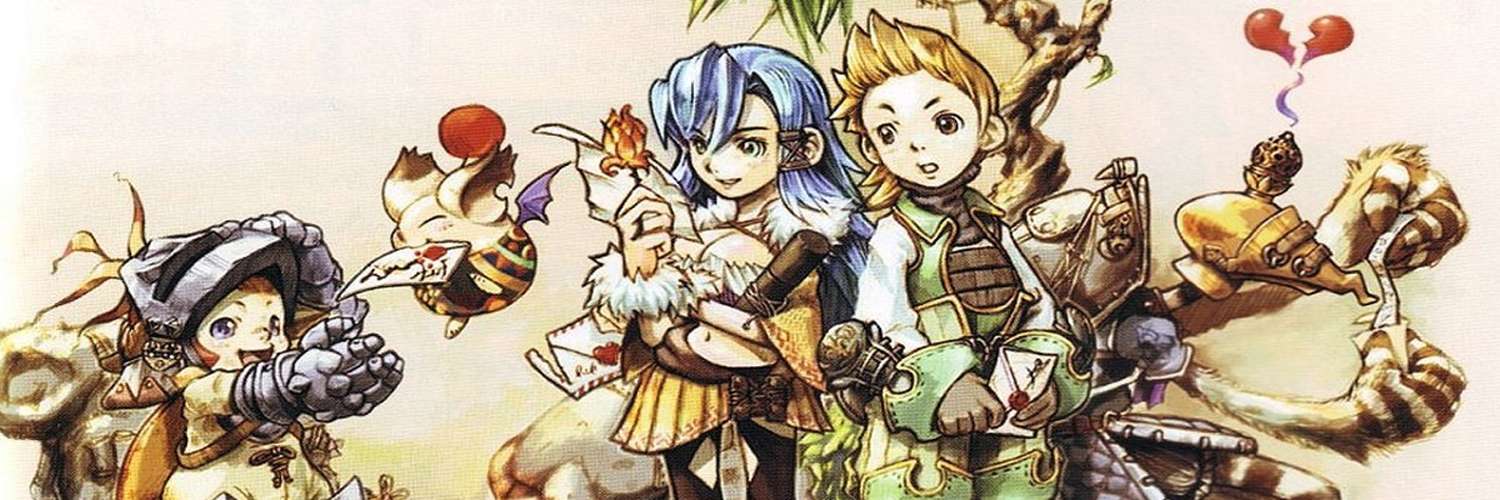
Final Fantasy Crystal Chronicles Remastered Edition Switch Review
At the time of this writing, Square had just recently unveiled the debut trailer for their next mainline entry in the Final Fantasy franchise. Developed by several key staff behind the highly acclaimed Final Fantasy XIV (following its relaunch with the rebranded A Realm Reborn), Final Fantasy XVI’s first look was met with overall positive impressions from the fanbase, but an unsurprising amount of negativity as well, mainly due to its gameplay veering further into real-time action rather than the slower turn-based menu-driven gameplay that defined the series for over half its lifespan.
Yet longtime fans should also be aware that this isn’t the first time Square has tinkered with the Final Fantasy formula; the first instance of experimentation took place as early as the second entry, though the results were divisive enough that the series stuck with the ATB system up until its tenth game. Since then, the series would diverge into wildly different genre shifts, including MMOs, fighting games, turn-based strategy, tower defense, rhythm games and even a third person shooter. Surprisingly, a beach volleyball spinoff remains on the table despite decades of beloved waifus and husbandos to potentially draw from.
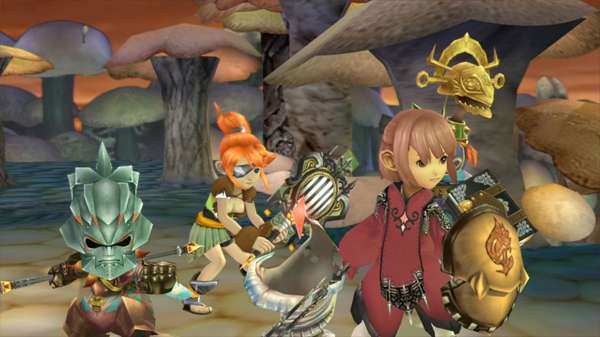
One of the most notable experiments happened back in 2003 with Final Fantasy: Crystal Chronicles on the Nintendo Gamecube. After years of estrangement between the two companies following Square’s infamous decision to move Final Fantasy VII to the Playstation, the once Nintendo-exclusive RPG series finally made its return on the Gamecube with a new and exclusive entry, just for the long-starved Nintendo fanbase….only it wasn’t at all what they were accustomed to.
Just a year prior, Final Fantasy XI had been the first game to introduce the concept of multiplayer to the franchise; while FFXI had followed the up-and-coming trend of online multiplayer through consoles, Crystal Chronicles opted for a much more obscure method of connecting would-be heroes together…and much more expensive. In order to achieve the maximum party of four, players needed a minimum of three Gameboy Advance handhelds and three GBA Link Cables. This was done so that each player had access to their own menu, map and equipment screens, rather than clutter up the TV. While pragmatic in nature, this setup also greatly limited the amount of players who could enjoy the game with all the factors in place other than the privileged few who had three other friends with GBAs, Link Cables and a desire to play anything on the Gamecube besides Smash Bros or Mario Kart.
After over a decade wallowing in classic console obscurity, Square has finally given fans new and old to experience Crystal Chronicles again, this time on modern systems with online functionality. Final Fantasy Crystal Chronicles Remastered Edition is a welcome modernization of a cult classic for fans, but how much of its dated mechanics have been given an overhaul, and how much of it still holds up among the more constantly re-released and recognizable FF entries?

Borrowing much of its aesthetic inspiration from Final Fantasy IX (something that is tragically underused in most other entries), Final Fantasy Crystal Chronicles employs a much more colorful and chibi artstyle, where characters are stout with Muppet-like proportions and races that come in all shapes and sizes, from the onion-like Lilties to the “what am I even looking at” faceless Yukes, with the more standard humanoids like Clavats and Selkies closer resembling characters like Zidane and Garnet from the aforementioned FFIX. Moogles are also glorified flying cotton balls, and even the most ferocious monsters wouldn’t look out of place as a marketable plushie.
Cute designs aside, the premise of Crystal Chronicles is much more grim in concept: the world is enveloped in a deadly miasma that spells poisonous death to any who enter it, requiring each neighboring settlement to erect a protective crystal to keep the miasma at bay. The big problem is that each crystal requires energy in the form of myrrh to keep the villages safe, which is why players are tasked to travel the outside world to collect myrrh from magical trees, which are naturally guarded by all sorts of nasty monsters.
Though the game does have a traditional narrative that should be familiar to most FF fans, it largely serves as window dressing for the largely non-linear structure of the game. Progress is divided into “years”, in which the player must travel all the nearby areas with myrrh to collect enough to bring home, then repeat the process after closing the year out with an adorable festival dance. Areas in the world map can be split into two categories: towns and dungeons. The former has the usual assortment of NPCs and shopkeepers to assist on the journey, while the latter is where the game’s combat takes center stage along with the desire to collect loot.
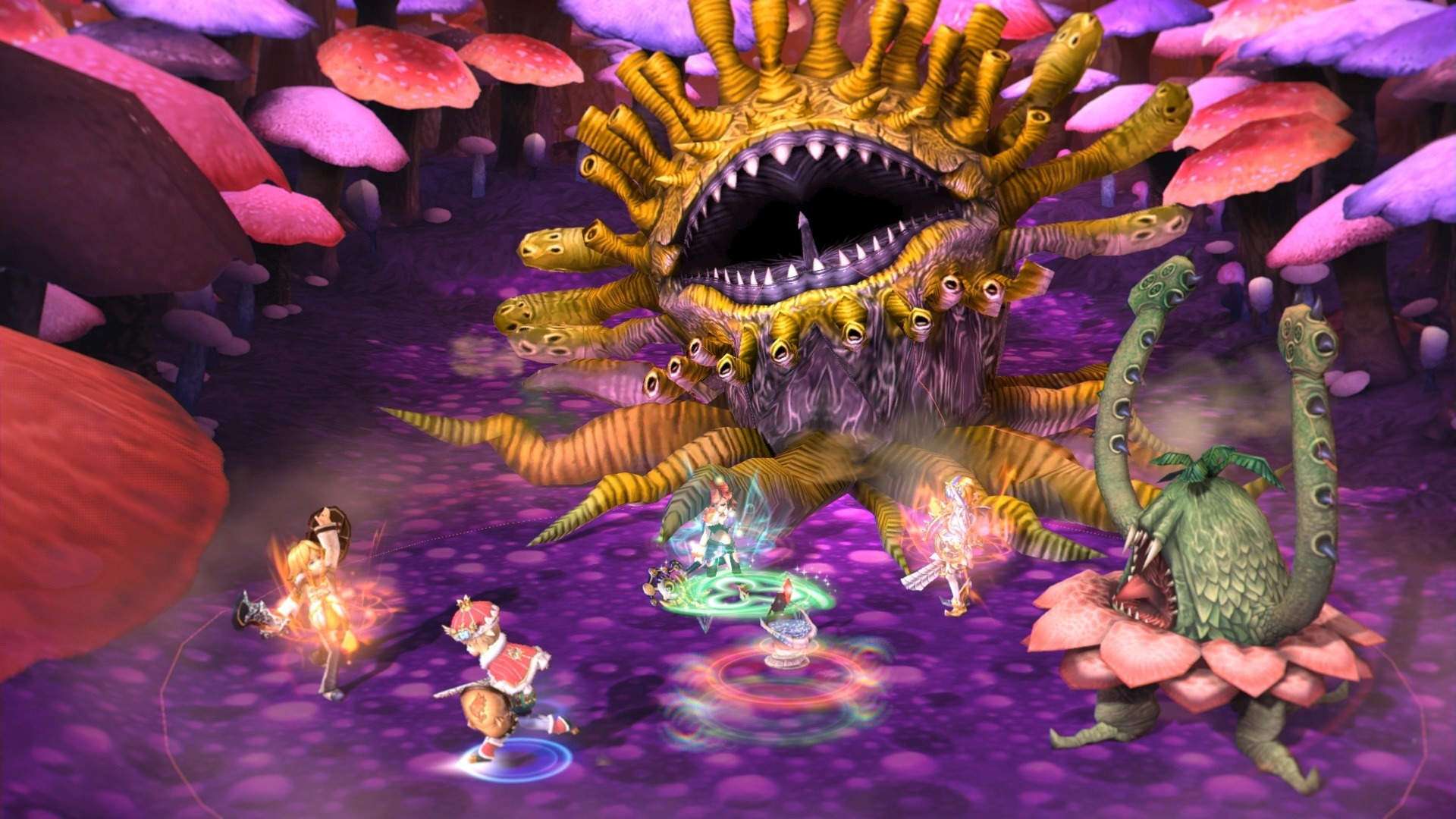
The combat system is the most drastic difference between Crystal Chronicles and other entries in the FF series, even today. Best described as a more methodically-paced Diablo and Torchlight, dungeons take place in an isometric view where players engage in real-time battle against enemies…or rather, partially real-time. While today’s players are more accustomed to instant attacks and spells mapped to shortcut keys/buttons, Crystal Chronicles forces players to commit to their actions ahead of time, as basic attacks require a long windup and a longer cooldown period, meaning that swinging too soon or too late in anticipation of an enemy could result in a missed attack or a damaging counterattack…sometimes both.
Spells offer an even bigger risk/reward, as they require charging by standing still and holding down the button until the spell reticule fills up. This leaves players particularly vulnerable, and requires an accurate assessment of where the enemy’s position will be so they take the full force of the spell. Even more restrictive is the fact that spells do not carry over between dungeons, and are instead dropped by enemies and chests; collecting a spell orb will automatically equip it to the character’s command deck, which is cycled with the shoulder buttons. This alone marks the most potentially frustrating part of Crystal Chronicles’ antiquated control scheme, as most loot-based games these days tend to feature an easier method of bouncing between abilities. Having to slowly cycle through the available commands only adds unnecessary tension in battle…even Attacking and Defending are on two separate slots rather than just having their own dedicated buttons, not to mention having to re-organize the spell and item list in every single dungeon.
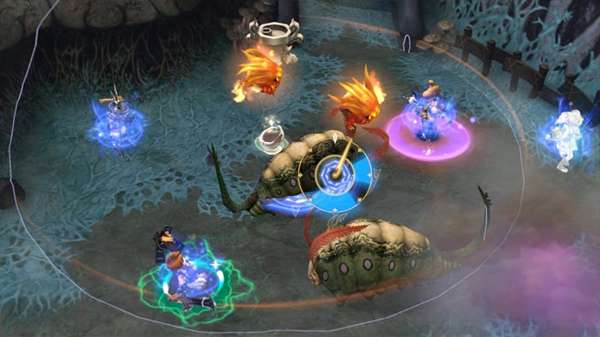
Speaking of items, Crystal Chronicles also does away with the traditional tried-and-true system of leveling through experience points. Instead, players must collect stronger weapons and armor, while also collecting artifacts that, upon completion of a dungeon, can be used to increase certain attributes including Strength, Defense, extra Hearts and extra Command Slots. Only one artifact can be redeemed per dungeon, so this will prompt the most repeated dungeon runs, in addition to extra materials needed to craft equipment. Yes, as another diverging mechanic that’s closer to loot-based dungeon crawlers, equipment must be crafted rather than bought, with the blacksmiths of each town requiring a blueprint and the right amount of materials in order to create that sturdier shield or sharper sword. Furthermore, certain pieces of equipment can only be equipped by certain races, although the game thankfully allows players to store excess equipment which can be retrieved by other custom characters they may choose to create.
Now comes the discussion of Crystal Chronicles’ most predominant feature, along with its most infamous mechanic; as with the original release, the big draw is the ability to run dungeons with other players, each with their own equipment and abilities as they work together to scour the dungeons, slay the boss and earn all the loot…but not the myrrh, as only the host of each session can earn the story-progressing elixir, which makes the only incentive for companions to collect whatever extra loot they can find.
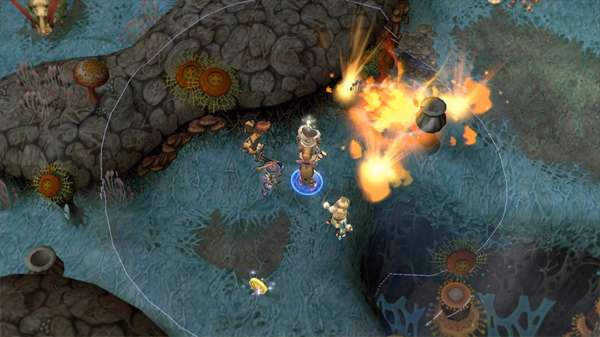
Anyone who is at least tangentially familiar with discussions of the original game’s release may be somewhat familiar with the bucket-carrying feature, a mandatory mechanic that was originally used to keep players restricted to the same cone of safety. As the bucket is used to create a barrier that protects the party from the miasma, stepping outside the borders of the barrier will result in fast-draining health. This is why one person must constantly carry the bucket around dungeons, which means they are unable to engage in any other action. The bucket can fortunately be dropped at any time and picked up by any other player, which is why the ideal team would pass around bucket duties rather than let one poor sod lug it around. For singleplayer excursions, said poor sod would be the player’s Moogle companion, who will solely engage as the bucket boy (but will also occasionally grow tired, thus decreasing its speed and ultimately requiring the player to carry it for a few arbitrary seconds).
This whole bucket business makes sense as far as a clever restriction to keep all players together on the same screen, but that’s all it is; whether the restriction can be tolerated or not will depend on the player, though it would have been far more tolerable if the person carrying the bucket wasn’t always automatically slower than everyone else, resulting in many instances of impatient party members slamming their faces into the barrier edges as they run around. In fact, the bucket itself serves as the ultimate reminder of how loot-based dungeon games have progressed over the years, and how Crystal Chronicles would have massively benefitted if the remaster had added more of these updated improvements.
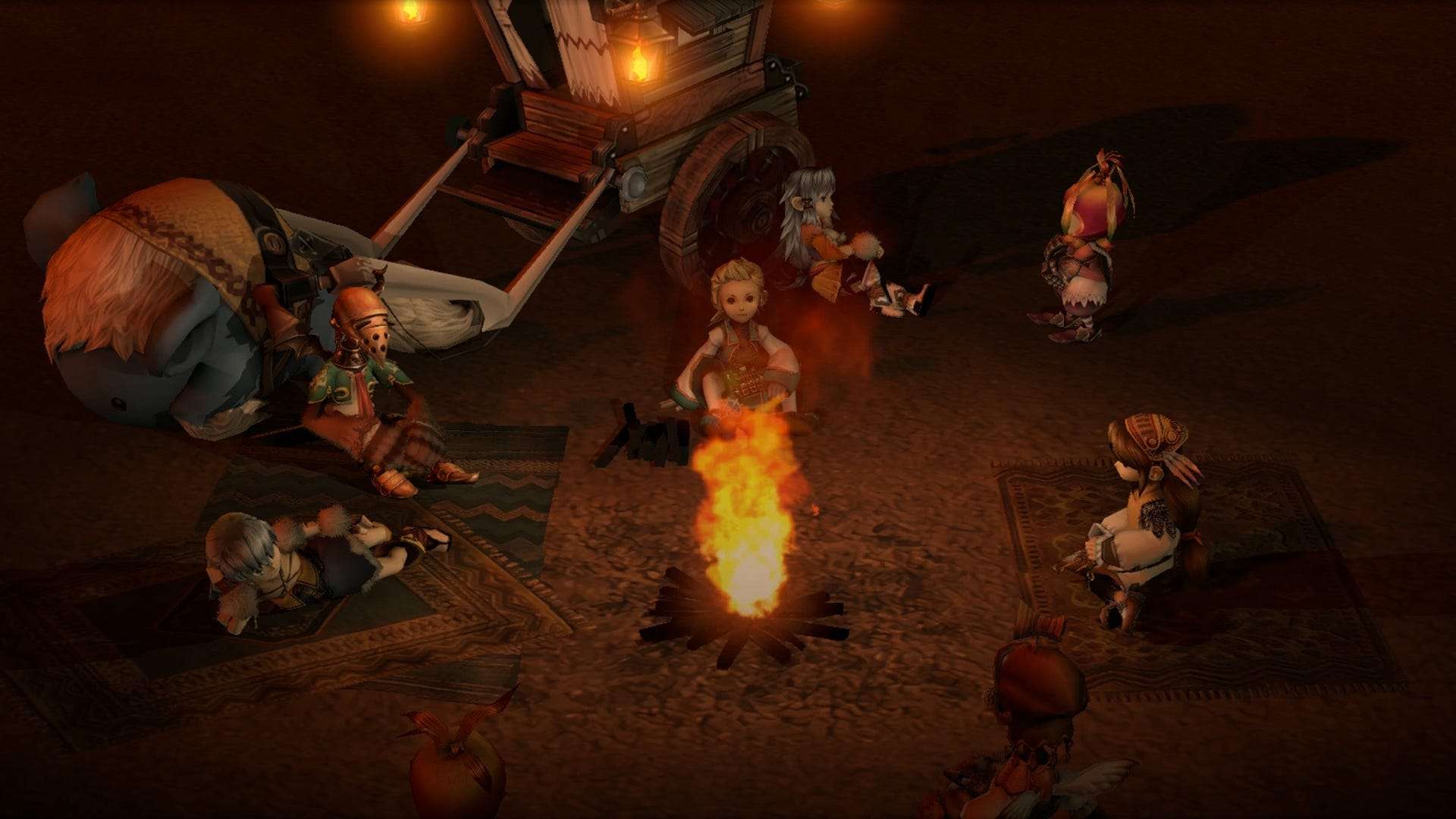
Speaking of which, the most modern inclusion to the remaster is of course the ability to play multiplayer online, with crossplay between different consoles and smartphones to boot. As great as this added feature is, it also comes with some heavy caveats. As previously stated, only the host player will gain story progression during these online team-ups, while players are also restricted to their respective regions when connecting, a baffling decision that greatly cuts down the potential matchmaking of this game. Communication is also severely lacking, as anyone not using a third party app like Discord will have to make due with the lackluster list of pre-written messages in the game itself. And for groups of friends who are able to meet face-to-face for couch co-op, they are now the ones left in the cold, as the Remaster has removed local co-op play entirely.
At least the game has received a notable facelift in both the visual and audio department. The game is unmistakably from the Gamecube era, but still looks very nice in higher resolutions, while the already memorable soundtrack has been given a re-orchestration that really lets RPG fans experience the folktale feeling that the music is going for. Voice acting has also been added to the game, but don’t expect anything special besides an average Anime Dub performance, which is only even present in a few lines of dialog anyway. The game is also hampered by frequent load times on the Switch, which aren’t super long so much as they pop up constantly. It’s especially annoying when a random cutscene plays in the world map, barely lasting a minute or two but with loading times in between transitions that make them feel twice as long.
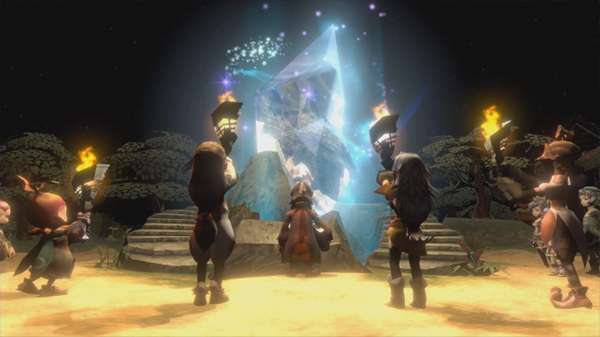
In conclusion, Final Fantasy Crystal Chronicles Remastered Edition is another classic FF game that featured a lot of revolutionary features for its time. Unlike other re-released FF games that aged like fine wine, however, Crystal Chronicles’ antiquated controls and half-step multiplayer additions don’t nearly stand the test of time, especially when there are so many games available that do loot-based dungeon-crawling far better and far more streamlined. For many modern gamers accustomed to the faster pace and tighter controls of said games, Crystal Chronicles may feel like an old relic that requires a hefty amount of patience. There’s no lack of charm in the visuals and character designs, and getting four synchronized party members together that can effortlessly chain spells together to unleash a powered-up super spell can lead to a decent time, but it also shows that some old games can be harder to revisit due to the rapidly-evolving technology surrounding videogames.
